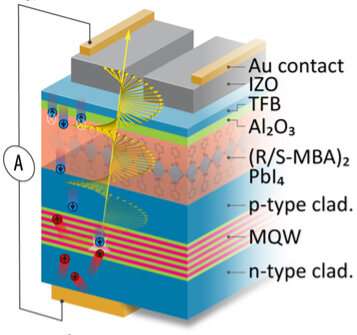
Spin LED stack emitting circularly polarized electroluminescence. The (R-MBA2The Pbl acts as a spin filter, allowing only polarized carriers (blue circles) to pass through the LED and recombine in the multiple quantum wells (MQWs) emitting circularly polarized light (yellow helix). Credit: Hautzinger, M. et al. Nature (2024)
Traditional electronics use semiconductors to transmit data in bursts of charge carriers (electrons or holes) to convey messages of “1s” and “0s.” Spintronic devices can process an order of magnitude more information by assigning a binary code to the orientation of the electrons’ magnetic poles, a property known as spin: an “up” spin is a 1, a “down” spin is a 0.
One of the major obstacles to commercializing spintronics is defining and maintaining the spin orientation of electrons. Most devices adjust spin orientation using ferromagnets and magnetic fields, a tedious and unreliable process. Decades of research have shown that carriers lose their spin orientation when moving from high-conductivity materials to low-conductivity materials, such as from metallic ferromagnets to undoped silicon and the conjugated polymer materials that make up most modern semiconductors.
For the first time, scientists have transformed existing optoelectronic devices into devices capable of controlling the spin of electrons at room temperature, without ferromagnets or magnetic fields.
Most optoelectronic devices, such as LEDs, control only charge and light, not electron spin. In a new study by physicists at the University of Utah and researchers at the National Renewable Energy Laboratory (NREL), the electrodes of store-bought LEDs were replaced with a patented spin filter made from a hybrid organic-inorganic material called perovskite. The LEDs produced circularly polarized light, a telltale sign that the filter had injected spin-aligned electrons into the LEDs’ existing semiconductor infrastructure, representing a huge advancement in spintronics technology.
“This is a miracle. For decades, we have been unable to efficiently inject spin-aligned electrons into semiconductors because of the mismatch between metallic ferromagnets and nonmagnetic semiconductors,” said Valy Vardeny, professor emeritus in the university’s Department of Physics and Astronomy and a co-author of the paper. “All types of devices that use spin and optoelectronics, such as spin LEDs or magnetic memory, will be excited by this discovery.”
The study was published in the journal Nature June 19, 2024.
Rotary filters
In 2021, the same collaborators developed a technology that acts as an active spin filter made of two successive layers of materials, called chiral organic-inorganic hybrid perovskites. Chirality describes the symmetry of a molecule, where its mirror image cannot superimpose itself on itself. Human hands are the classic example: hold yours out, palms facing out. The right and left hands are arranged as mirrors of each other: you can turn your right hand 180° to match the silhouette, but now the right palm is facing you while the left palm is facing out. They are not identical.
Some molecules, such as DNA, sugar, and chiral halogenated organic hybrid perovskite layers, have their atoms arranged in chiral symmetry. The filter works by using a chiral layer oriented “leftward” to allow electrons with “up” spin to pass through, but block electrons with “down” spin, and vice versa. At the time, the scientists claimed that the discovery could be used to transform conventional optoelectronics into spintronic devices simply by incorporating the chiral spin filter. That’s exactly what the new study did.
“We took an LED off the shelf. We removed one electrode and put in the spin filter material and another ordinary electrode. And voila! The light was strongly circularly polarized,” Vardeny said.
NERL chemists made the spin LEDs by stacking multiple layers, each with specific physical properties. The first layer is a common transparent metal electrode; the second layer’s material blocks electrons with spin in the wrong direction, a layer the authors call a chirality-induced spin filter.
The spin-aligned electrons then recombine in the third layer, a standard semiconductor used as the active layer in conventional LEDs. The injected spin-aligned electrons cause this layer to produce photons that travel in unison along a spiral trajectory, rather than a conventional wave pattern, to produce the LED’s characteristic circularly polarized electroluminescence.
“This work demonstrates the unique and powerful ability of these emerging ‘hybrid’ semiconductors to combine and leverage the interplay of distinct properties of organic and inorganic systems,” said Matthew Beard, a co-author of the NREL study. “Here, chirality is borrowed from organic molecules and provides spin control while the inorganic component orients the organic component and provides conductivity or charge control.”
Once the filter was installed in a standard LED, Xin Pan, a research assistant in the university’s Department of Physics and Astronomy, confirmed that the device worked as expected, namely by using electrons aligned with their spins. However, more research is needed to explain the exact mechanisms at work to create the polarized spins.
“That’s the $64,000 question that a theorist has to answer,” Vardeny said. “It’s really a miracle. And the miracle happens without knowing exactly what the underlying mechanism is. That’s the beauty of being an experimentalist. You just have to try.”
The authors say other scientists can apply the technique using other chiral materials, such as DNA, in many contexts.
More information:
Matthew P. Hautzinger et al., Room-temperature spin injection across a chiral perovskite/III–V interface, Nature (2024). DOI: 10.1038/s41586-024-07560-4
Provided by the University of Utah
Quote:’Miracle’ filter turns store-bought LEDs into spintronic devices (2024, July 25) Retrieved July 27, 2024 from https://phys.org/news/2024-07-miracle-filter-bought-spintronic-devices.html
This document is subject to copyright. Apart from any fair dealing for the purpose of private study or research, no part may be reproduced without written permission. The content is provided for informational purposes only.